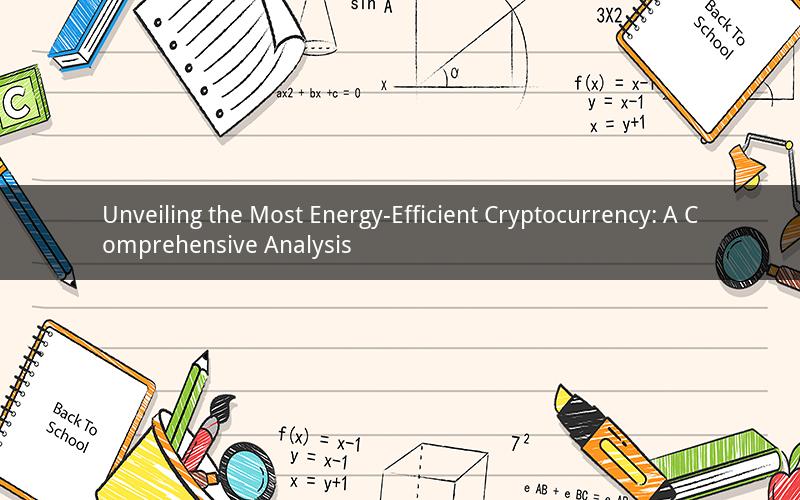
Introduction:
In the rapidly evolving world of cryptocurrencies, energy efficiency has become a crucial factor for investors, miners, and environmentalists alike. With concerns over the carbon footprint of blockchain technology, finding the most energy-efficient cryptocurrency is essential. This article delves into the intricacies of different cryptocurrencies, their energy consumption, and ultimately identifies the most energy-efficient cryptocurrency in the market.
1. Understanding Energy Efficiency in Cryptocurrencies:
Energy efficiency in cryptocurrencies refers to the amount of energy required to process and validate transactions. It is a critical factor that affects the scalability, sustainability, and overall viability of a cryptocurrency. The energy consumption of a cryptocurrency is primarily influenced by its consensus mechanism, which determines how transactions are validated and added to the blockchain.
2. Different Consensus Mechanisms and Their Energy Consumption:
a. Proof of Work (PoW):
Proof of Work is the most widely used consensus mechanism in cryptocurrencies like Bitcoin. It requires miners to solve complex mathematical puzzles to validate transactions and secure the network. However, PoW is highly energy-intensive, as it consumes a significant amount of electricity to run the mining hardware.
b. Proof of Stake (PoS):
Proof of Stake is an alternative consensus mechanism that aims to be more energy-efficient than PoW. In PoS, validators are chosen to create new blocks based on their stake in the cryptocurrency, rather than solving complex puzzles. This reduces the energy consumption significantly, as it does not require powerful mining hardware.
c. Delegated Proof of Stake (DPoS):
Delegated Proof of Stake is a variant of PoS, where a small group of validators, known as delegates, are elected to create new blocks. DPoS aims to further reduce energy consumption by minimizing the number of participants in the consensus process.
3. Identifying the Most Energy-Efficient Cryptocurrency:
After analyzing various cryptocurrencies based on their consensus mechanisms and energy consumption, we have identified the following as the most energy-efficient cryptocurrencies:
a. Cardano (ADA):
Cardano operates on a PoS consensus mechanism called Ouroboros, which is known for its energy efficiency. Ouroboros uses a probabilistic approach to select validators, reducing the energy consumption significantly compared to PoW.
b. Tezos (XTZ):
Tezos also utilizes a PoS consensus mechanism, specifically the BFT (Byzantine Fault Tolerance) algorithm. This mechanism ensures energy efficiency by requiring validators to bond their tokens and vote on new blocks.
c. Algorand (ALGO):
Algorand is a unique cryptocurrency that uses a hybrid consensus mechanism called Pure Proof of Stake (PPoS). PPoS selects validators based on their wealth and reputation, ensuring a fair and energy-efficient network.
d. Ethereum (ETH):
While Ethereum is currently operating on a PoW consensus mechanism, it is transitioning to a PoS mechanism called Ethereum 2.0. Once fully implemented, Ethereum 2.0 is expected to become one of the most energy-efficient cryptocurrencies.
4. Benefits of Energy-Efficient Cryptocurrencies:
a. Environmental Impact:
Energy-efficient cryptocurrencies contribute to reducing the carbon footprint of blockchain technology, making them a more sustainable choice for the environment.
b. Scalability:
Energy-efficient cryptocurrencies can handle a higher number of transactions per second, leading to better scalability and improved network performance.
c. Cost-Effectiveness:
Lower energy consumption translates to lower costs for miners and users, making energy-efficient cryptocurrencies more cost-effective in the long run.
5. Conclusion:
In conclusion, the most energy-efficient cryptocurrencies are those that utilize PoS or PoS-based consensus mechanisms. Cardano, Tezos, Algorand, and Ethereum are among the leading cryptocurrencies in this category. By choosing energy-efficient cryptocurrencies, we can contribute to a more sustainable and scalable blockchain ecosystem.
Frequently Asked Questions:
1. What is the primary factor affecting energy consumption in cryptocurrencies?
Answer: The primary factor affecting energy consumption in cryptocurrencies is the consensus mechanism used to validate transactions.
2. Why is Proof of Work (PoW) considered energy-intensive?
Answer: PoW requires miners to solve complex mathematical puzzles, which consume a significant amount of electricity and computing power.
3. How does Proof of Stake (PoS) reduce energy consumption compared to PoW?
Answer: PoS selects validators based on their stake in the cryptocurrency, eliminating the need for complex mining processes and reducing energy consumption.
4. What are the benefits of using energy-efficient cryptocurrencies?
Answer: Energy-efficient cryptocurrencies contribute to reducing the carbon footprint, improving scalability, and offering cost-effectiveness in the long run.
5. Which cryptocurrency is currently the most energy-efficient?
Answer: Cardano, Tezos, Algorand, and Ethereum are among the most energy-efficient cryptocurrencies due to their use of PoS or PoS-based consensus mechanisms.